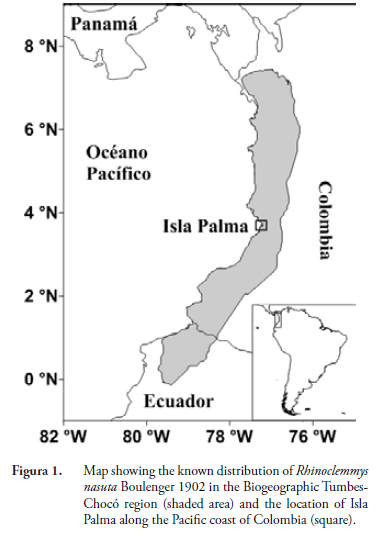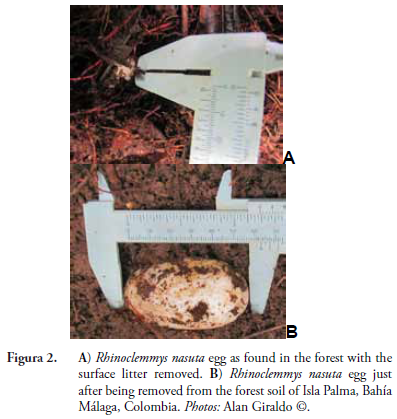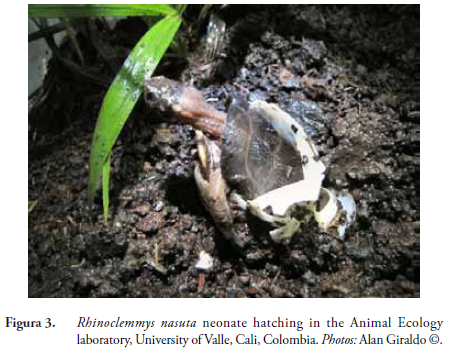Servicios Personalizados
Revista
Articulo
Indicadores
-
 Citado por SciELO
Citado por SciELO -
 Accesos
Accesos
Links relacionados
-
 Citado por Google
Citado por Google -
 Similares en
SciELO
Similares en
SciELO -
 Similares en Google
Similares en Google
Compartir
Boletín Científico. Centro de Museos. Museo de Historia Natural
versión impresa ISSN 0123-3068
Bol. Cient. Mus. Hist. Nat. Univ. Caldas vol.17 no.2 Manizales jul./dic. 2013
SHORT COMMUNICATION
FIRST REPORT OF HATCHING OF THE CHOCOAN RIVER TURTLE Rhinoclemmys nasuta (BOULENGER 1902) (TESTUDINES: GEOEMYDIDAE)*
PRIMER REPORTE DE ECLOSIÓN DE LA TORTUGA CHOCOANA DE RÍO, Rhinoclemmys nasuta (BOULENGER 1902) (TESTUDINES: GEOEMYDIDAE)
Alan Giraldo1, Mario F. Garcés-Restrepo1,2 , Wilmar Bolívar-G1, 2 and John L. Carr1,3
* FR: 16 Julio 2012. FA: 29 Julio 2013.
1 Universidad del Valle, Facultad de Ciencias Naturales y Exactas, Departamento de Biología, Sección de Zoología, Grupo de Investigación en Ecología Animal. Cali. E-mail: alan.giraldo@correounivalle.edu.co; ecologia@univalle.edu.co
2 Universidad del Valle, Facultad de Ciencias Naturales y Exactas, Departamento de Biología, Programa de Postgrado en Ciencias - Biología.
3 University of Louisiana at Monroe, Department of Biology and Museum of Natural History. Monroe, Louisiana, 71209-0520. USA. E-mail: carr@ulm.edu
Abstract
Rhinoclemmys nasuta (Boulenger 1902) is a medium-sized aquatic turtle that inhabits rivers and creeks in the Tumbes-Chocó biogeographic region. An egg of R. nasuta was found with about 95% of its surface area buried in the forest substrate of Isla Palma (Bahía Málaga, Colombia) and it was transported to the laboratory. The time to complete incubation was 66 days. Neonate size on the day it hatched was 58.4 mm straight carapace length, 34.6 mm straight carapace width, 55.3 mm straight plastron length, 30 mm maximum shell height and it weighed 33 g. This is the first report of an R. nasuta egg hatched under either natural or laboratory conditions.
Key words: Testudines, Geoemydidae, Rhinoclemmys, Isla Palma, Colombia, Tumbes-Chocó.
Resumen
Rhinoclemmys nasuta (Boulenger 1902) es una tortuga acuática de tamaño mediano que habita en los ríos y quebradas de la región biogeográfica Tumbes-Chocó. Se encontró un huevo de R. nasuta enterrado en un 95% en el suelo del bosque en la localidad de Isla Palma (Bahía Málaga, Colombia) y fue transportado al laboratorio. Después de 66 días de incubación, el tamaño del recién nacido cuando eclosionó fue de 58,4 mm de longitud de caparazón, 34,6 mm de ancho de caparazón, 55,3 mm de longitud del plastrón, 30 mm de altura máxima de la concha y pesó 33 g. Este es el primer reporte de un huevo de R. nasuta incubado exitosamente ya sea bajo condiciones de laboratorio o en condiciones naturales.
Palabras clave: Testudines, Geoemydidae, Rhinoclemmys, Isla Palma, Colombia, Tumbes-Chocó.
Rhinoclemmys nasuta (Boulenger 1902), is an endemic species registered in the Colombian red book of reptiles (IPPI & FLORES, 2001; CASTAÑO-MORA, 2002). This is a medium-sized aquatic turtle, often considered the most aquatic species of the genus, which inhabits rivers and creeks in the Tumbes-Chocó biogeographic region (Figure 1) from the Esmeraldas River basin (Ecuador) to the middle region of the Atrato River (Chocó, Colombia) (MEDEM, 1962; CARR & ALMENDÁRIZ, 1990; CARR & GIRALDO, 2009).

Currently, the only reproductive data for the species was reported by MEDEM (1962). According to residents within the natural range, R. nasuta clutches consist of one or two eggs laid anytime during the year, but primarily between January and March. Nevertheless, based on his dissection information MEDEM (1962) found only one egg per clutch in the months of November, December and April. In addition, based on the presence of enlarged ovarian follicles of various sizes, he suggested that oviposition could occur throughout the year. He reported the size of three eggs, which are hard-shelled, white and elongate ellipsoids measuring between 35 to 39 mm wide and 67 to 70 mm long (MEDEM, 1962; CARR & GIRALDO, 2009).
Conservation concerns for this species include indirect threats from habitat modification by timber harvesting and changes in land use (CARR et al., 2012), as well as various forms of direct consumption. Humans use turtles of this species as a source of protein or in traditional medicinal practices (CASTAÑO-MORA & MEDEM, 1983; GALVIS-RIZO & CORREDOR-LONDOÑO, 2006), as well as frequently being used as pets and their shells are used in constructing decorative items (CORREDOR-LONDOÑO et al., 2006; GALVIS-RIZO & CORREDOR-LONDOÑO, 2006; CORREDOR-LONDOÑO et al., 2007; CARR & GIRALDO, 2009). However, the lack of data on the natural history and ecology of this species has impeded an appropriate evaluation of its conservation status (CARR & GIRALDO, 2009).
On April 15 of 2011, an egg of R. nasuta was located buried in the soil (Figure 2A) during an intensive search for terrestrial turtles on Isla Palma, Bahía Málaga, Colombia (3o54' N – 77o21' W, Figure 1). This island is located in the Colombian Pacific region where the annual precipitation ranges between 7200 mm year-1 to 8500 mm year-1, the relative humidity is above 80%, the air temperature ranges between 23.5ºC to 25.7ºC, and the dominant vegetation is very humid lowland tropical forest (RANGEL-CH. & ARELLANO-P., 2004). A more extensive description of the 138 ha island can be found in GIRALDO et al. (2012).
The egg was located 7.4 m from the nearest stream, about 2 m above the river level on a small terrace with a 15% slope. It was found in an area with a closed forest canopy overhead, with approximately 95% of its surface area buried in the soil, where it was surrounded by tree roots and covered with sticks and leaf litter (Figure 2A). The elongate egg was lying in the ground inclined at 5o to the horizon.

The R. nasuta egg was unearthed, cleaned, measured and weighed in situ (Figure 2B). The egg was 63.8 mm long, 35.4 mm wide and weighed 45.8 g. Then it was transported in soil to the Animal Ecology Laboratory at the University of Valle, in Cali, Colombia, where it was reburied in a terrarium similar to the way it was found buried in the forest. The terrarium was a 10 gallon plastic aquarium with potting soil and ornamental plants in order to simulate the island environment. 100 ml of water was sprayed as a mist into the terrarium every day in order to offset any evaporation and maintain the relative humidity above 80%. Minimal humidity inside the terrarium, minimal and maximal air temperature, and soil temperature near the egg were recorded every three days during the incubation period using a digital thermo-hygrometer and a soil thermometer. In order to facilitate the free exchange of air, the terrarium did not have an air-tight lid. The laboratory incubation period was 66 days, but it was not possible to estimate the date the egg was laid. When found, the egg was already entirely chalky white. The mean soil temperature near the egg during incubation was 20.2±0.6oC, and the minimal and maximal air temperature in the terrarium was 24.8±0.8 and 26.9±1.1oC respectively (mean±SD, n = 22).
The hatchling turtle first broke (pipped) the egg on the end by its head and then remained inside the eggshell for four hours before it completely emerged from the shell. Once out of the egg, it buried itself in the soil of the terrarium. The R. nasuta neonate's size on the day it hatched was 58.4 mm straight carapace length (CL), 34.6 mm straight carapace width, 55.3 mm straight plastron length, 30 mm maximum shell height, and it weighed 33 g (Figure 3). As is typical for most turtle hatchlings, there was some unfolding that occurred in the days after hatching (EWERT, 1979), and the carapace measurements seven days later were 64.2 mm straight carapace length (CL), 55.8 mm straight plastron length, 24.6 mm maximum shell height and it weighed 42.5 g.

MEDEM (1962) reported that female R. nasuta do not dig a nest, or they do not cover the eggs with soil; however, his information came from local inhabitants rather than first-hand observations. In contrast, we found the egg almost completely buried in the soil and covered with sticks and leaf litter. Based on available information, the single egg we found constitutes a clutch. Females of other species of Rhinoclemmys such as R. funerea (Cope 1875) and R. pulcherrima (Gray 1856) are reported to dig nests as a part of their reproductive behavior (CASTILLO-CENTENO, 1986; MONGE-NÁJERA et al., 1988); however, according to PRITCHARD & TREBBAU (1984), R. punctularia (Daudin 1801) and R. diademata (Mertens 1954) females do not dig nests, but the eggs soon become inconspicuous as mud and fallen leaves cover them on the wet forest floor. Our report is the only report of a R. nasuta egg found in the wild or from captive individuals and so we cannot generalize about the nesting behavior that the species exhibits.
Hatchling size is an important parameter in the life history of an organism (SHINE & IVERSON, 1995; STEARNS, 1992), and it is a key element in adjusting species-specific growth models in turtles (ANDREWS, 1982; SPENCER, 2002). Herein we made the first report of body size for a specimen of R. nasuta hatched under either natural or laboratory conditions. The eggs of R. nasuta are relatively large in relation to the size of the females (MEDEM, 1962; CARR & GIRALDO, 2009), and the hatchling is correspondingly large. The large size of the hatchling places it among the group of Rhinoclemmys species having the largest hatchlings (> 55 mm CL), including R. annulata (Gray 1860), R. funerea, R. melanosterna (Gray 1861), and R. punctularia (CASTAÑO-MORA & MEDEM, 1983; RHODIN & CARR, 2009). Nevertheless, the egg reported here is smaller than any previously reported (MEDEM, 1962), and thus expands our knowledge of egg size range for this species. Recently, GIRALDO et al. (2012) reported 68.4 mm CL as the smallest R. nasuta recorded in the wild population from Isla Palma. However, our results suggest that the hatchling size range of R. nasuta extends at least 10 mm lower.
This information increases our knowledge of the natural history of this species and should strengthen conservation initiatives for endemic Neotropical turtles. Reproductive information is among the most critical aspects of life history required for assessing the conservation status of a species, yet in many cases as with R. nasuta, this information has been very difficult to obtain and will be slow to accumulate given the species' low reproductive potential.
ACKNOWLEDGEMENTS
We are grateful to Luz Karime Sánchez, Ángela María González, and Manuel Sánchez for their help during fieldwork. The Dirección General Marítima de Colombia (DIMAR) and the Unidad Administrativa Especial del Sistema de Parques Nacionales Naturales de Colombia (UAESPNN) granted access to Isla Palma for our R. nasuta survey. Fieldwork was funded by Departamento de Biología at Universidad del Valle.
BIBLIOGRAPHY
ANDREWS, R.M., 1982.- Patterns of growth in reptiles: 273-320 (in) GANS, C. & POUGH, F.H. (eds.) Biology of the Reptilia, Physiological Ecology. Vol. 13. Academic Press, New York, USA. [ Links ]
CARR, J.L. & ALMENDÁRIZ, A., 1990.- Contribución al conocimiento de la distribución geográfica de los quelonios del Ecuador occidental. Politécnica, 14 (3): 75-103. [ Links ]
CARR, J.L. & GIRALDO, A., 2009.- Rhinoclemmys nasuta (Boulenger 1902), Large-Nosed Wood Turtle, Chocoan River Turtle (in) RHODIN, A.G.J., P.C.H. PRITCHARD, P.P. van DYKE, SAUMURE, R.A., BUHLMANN, K.A., IVERSON, J.B. & MITTERMEIER, R.A. (eds.) Conservation Biology of Freshwater Turtles and Tortoises: A Compilation Project of the IUCN/SSC Tortoise and Freshwater Turtle Specialist Group. Chelonian Research Monographs, 5: 034.1-034.6. [ Links ]
CARR, J.L., GIRALDO, A. & GARCÉS-RESTREPO, M.F., 2012.- Rhinoclemmys nasuta (Boulenger 1902): 315-322 (in) PÁEZ, V., MORALES-BETANCOURT, M.A., LASSO, C.A., CASTAÑO-MORA, O.V. & BOCK, B. (eds.) Biología y Conservación de las Tortugas Continentales de Colombia. Instituto de Investigación de los Recursos Biológicos Alexander von Humboldt (IAvH), Bogotá, Colombia. [ Links ]
CASTAÑO-MORA, O.V. (ed.)., 2002.- Libro rojo de reptiles de Colombia. Libros Rojos de Especies Amenazadas de Colombia. Instituto de Ciencias Naturales-Universidad Nacional de Colombia, Ministerio del Medio Ambiente, Conservación Internacional-Colombia. Bogotá, Colombia. [ Links ]
CASTAÑO-MORA, O.V. & MEDEM, F., 1983.- Datos preliminares sobre la reproducción de Rhinoclemmys melanosterna Gray (Reptilia: Quelonia: Emydidae). Lozania Acta Zoológica Colombiana, 47: 1-6. [ Links ]
CASTILLO-CENTENO, V.E., 1986.- Factores ecológicos y de mercado de la reproducción de Rhinoclemmys pulcherrima y Kinosternon scorpioides (Testudines: Emydidae y Kinosternidae) en Costa Rica: Trabajo de Grado, Universidad de Costa Rica, San José, Costa Rica. [ Links ]
CORREDOR-LONDOÑO, G., AMOROCHO, D. & GALVIS-RIZO, C.A., 2006.- Plan de Acción para la Conservación de las Tortugas Continentales y Marinas del Departamento del Valle del Cauca. Corporación Autónoma Regional del Valle del Cauca (CVC), Santiago de Cali, Colombia. [ Links ]
CORREDOR-LONDOÑO, G., KATTAN, G., GALVIS-RIZO, C.A. & AMOROCHO, D., 2007.- Tortugas del Valle del Cauca. Corporación Autónoma Regional del Valle del Cauca (CVC), Santiago de Cali, Colombia. [ Links ]
EWERT, M.A., 1979.- The embryo and its egg: development and natural history: 333-413 (in) HARLESS, M. & MORLOCK, H. (eds.) Turtles: Perspectives and Research. John Wiley and Sons, New York, USA. [ Links ]
GALVIS-RIZO, C.A. & CORREDOR-LONDOÑO, G., 2006.- Evaluación del uso de las tortugas continentales en la costa Pacífica del Departamento del Valle del Cauca. Fundación Zoológica de Cali, Santiago de Cali, Colombia. [ Links ]
GIRALDO, A., GARCÉS-RESTREPO, M.F., CARR, J.L. & LOAIZA, J., 2012.- Tamaño y estructura poblacional de la Tortuga Sabaletera (Rhinoclemmys nasuta, Testudines: Geoemydidae) en un ambiente insular del Pacífico colombiano. Caldasia, 34 (1): 109-125. [ Links ]
IPPI, S. & FLORES, V., 2001.- Las tortugas neotropicales y sus áreas de endemismo. Acta Zoológica Mexicana, 84: 49-63. [ Links ]
MEDEM, F., 1962.- La distribución geográfica y ecología de los Crocodylia y Testudinata en el Departamento del Chocó. Revista de la Academia Colombiana de Ciencias Exactas, Físicas y Naturales, 11: 279-303. [ Links ]
MONGE-NÁJERA, J., MORERA, B. & CHÁVEZ, M., 1988.- Nesting behaviour of Rhinoclemmys pulcherrima in Costa Rica (Testudines: Emydidae). Herpetological Journal, 1: 308. [ Links ]
PRITCHARD, P.C.H. & TREBBAU, P. 1984.- The Turtles of Venezuela. Society for the Study of Amphibians and Reptiles, Oxford, Ohio, USA. [ Links ]
RANGEL-CH., J.O. & ARELLANO-P., H., 2004.- El Chocó Biogeográfico: ambiente físico: 39-82 (in) RANGEL-CH., J.O. (ed.) Colombia Diversidad Biótica IV: El Chocó Biogeográfico/Costa Pacífica. Instituto de Ciencias Naturales, Universidad Nacional de Colombia, Bogotá, Colombia. [ Links ]
RHODIN, A.G.J. & CARR, J.L., 2009.- A quarter millennium of uses and misuses of the turtle name Testudo scabra: identification of the type specimens of T. scabra Linnaeus 1758 (= Rhinoclemmys punctularia) and T. scripta Thunberg in Schoepff 1792 (= Trachemys scripta scripta). Zootaxa, 2226: 1-18. [ Links ]
SHINE, R. & IVERSON, J.B., 1995.- Patterns of survival, growth and maturation in turtles. Oikos, 72: 343-348. [ Links ]
SPENCER, R.-J., 2002.- Growth patterns of two widely distributed freshwater turtles and a comparison of common methods used to estimate age. Australian Journal of Zoology, 50: 477-490. [ Links ]
STEARNS, S.C., 1992.- The Evolution of Life Histories. Oxford University Press, New York, USA. [ Links ]













